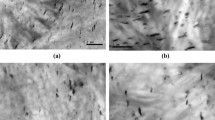Abstract
Polypropylene/clay nanocomposites were studied with focus on optimization of mixing conditions. Two different types of commercial nanofillers Dellite® were used (Dellite® 72T and Dellite® 67G). Effect of various concentrations of fillers on morphology and mechanical properties was investigated. Conditions of preparation were varied with respect to mixing time and speed of rotation of kneaders. Results of morphology study showed that nanocomposites contained agglomerates of nanofillers. The comparison of the filler types revealed that better dispersion and distribution was found for nanocomposites containing Dellite 72T which had also better tensile strength. Optimum mixing time was 30 min. 3D graphical analysis showed that the optimum speed of rotation was 60 rpm and with increasing clay content (2–10 wt%) the tensile strength increased.







Similar content being viewed by others
References
Nam PH et al (2001) A hierarchal structure and properties of intercalated polypropylene/clay nanocomposites. Polymer 42:9633–9640
Svoboda P et al (2002) Morphology and mechanical properties of polypropylene/organoclay nanocomposites. J Appl Polym Sci 85:1562–1570
Zhong Y et al (2007) Mechanical and oxygen barrier properties of organoclay-polyethylene nanocomposites films. Polym Eng Sci 47:1101–1107
Shaofeng W et al (2003) Preparation of polyethylene-clay nanocomposites directly from Na montmorillonite by a melt intercalation method. J Appl Poly Sci 89:2583–2585
Vlasveld DNP et al (2005) Analysis of the modulus of polyamide-6 silicate nanocomposites using moisture controlled variation of the matrix properties. Polymer 46:6102–6113
Fornes TD et al (2005) Effect of organoclay structure on nylon 6 nanocomposite morphology and properties. Polymer 46:8641–8660
Morgan AB, Chu L-L, Harris JD (2005) A flammability performance comparison between synthetic and natural clays in polystyrene nanocomposites. Fire Mater 29:213–229
Nazarenko S et al (2005) Gas barrier of polystyrene montmorillonite clay nanocomposites: effect of mineral layer aggregation. Fire Mater 29:213–229
Kato M, Usuki A, Okada A (1997) Synthesis of polypropylene oligomer-clay intercalation compounds. J Appl Polym Sci 66:1781–1785
Tjong SC, Meng YZ (2003) Impact-modified polypropylene/vermiculite nanocomposites. J Polym Sci B 41:2332–2341
Tjong SC, Meng YZ, Xu Y (2002) Preparation and properties of polyamide6/polypropylene-vermiculite nanocomposite/polyamide 6 alloys. J Appl Polym Sci 86:2330–2337
Ku BC, Froio D, Steeves D, Kim DW, Ahn H, Ratto JA et al (2004) Cross-linked multilayer polymer-clay nanocomposites and permeability properties. J Macromol Sci A 41:2441–2446
Wu T-M, L Yi-H, Hsu S-F (2004) Isothermal crystallization kinetics and melting behavior of nylon/saponite and nylon/montmorillonite nanocomposites. J Appl Polym Sci 94:2196–2204
Nguyen QT, Baird DG (2007) An improved technique for exfoliating and dispersing nanoclay particles into polymer matrices using supercritical carbon dioxide. Polymer 48:6923–6933
Hasegava N, Usuki A (2004) Silicate laver exfoliation in polvolefin/clay nanocomposites based on maleic anhydride modified polyolefins and organophilic clay. J Appl Polym Sci 93:464–470
Martin D et al (2003) Polyethylene/layered silicate nanocomposites for rotational moulding. Polymer Int 52:1774–1779
Acknowledgement
This study was supported by Board of Trade in the frame of project FI-IM3/085. The authors express thanks to Mr. Jakub Hnilicka for the melt compounding.
Author information
Authors and Affiliations
Corresponding author
Rights and permissions
About this article
Cite this article
Kubišová, H., Měřínská, D. & Svoboda, P. PP/clay nanocomposite: optimization of mixing conditions with respect to mechanical properties. Polym. Bull. 65, 533–541 (2010). https://doi.org/10.1007/s00289-010-0269-y
Received:
Revised:
Accepted:
Published:
Issue Date:
DOI: https://doi.org/10.1007/s00289-010-0269-y




